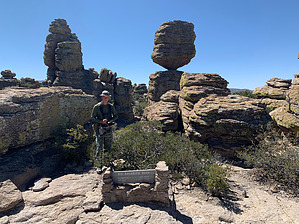| Guide | ♦ | 47 Triplogs | 0 Topics |
details | drive | permit | forecast | 🔥 route |
stats |
photos | triplogs | topics | location |
| 415 | 47 | 0 |
one thousand tons proportionally weighted by markthurman53  CHIRICAHUA NATIONAL MONUMENT CHIRICAHUA NATIONAL MONUMENTChiricahua National Monument is on the north side of the Chiricahua Mountains in the Southeast corner of Arizona. About as far southeast as you can go in Arizona without being in New Mexico or Mexico. This is almost a fairy tale land of Rock spires, pinnacles, balanced rocks, and hoodoos where the laws of gravity don’t seem to apply. Although the park road traverses the park, to fully enjoy this park requires getting out of the car and hiking some of the 17 miles of trails. All the trails in the park are in excellent condition and well signed. This 12000-acre park was established on April 18, 1924, to preserve the park's natural wonders of weathered volcanic tuff. In 1934 during the great depression, the CCC built the park buildings, many of which still exist today. The many park trails throughout the park today were also constructed by the CCC. Before the monument's 1880s existence, the area was settled by ranchers and, prior to that, the Apaches. The monument has displays on the history, plants, and animals of this unique environment.
If you don’t mind the 2-hour drive from Tucson, Chiricahua Monument is a great place to visit and hike the scenic packed trails. This is relatively remote, so usually not crowded. The four or five times I have been there less than 50 visitors, and at least two of the times less than four cars in the park, and one of them was a park ranger (During the COVID thing). BIG BALANCED ROCK TRAIL Overview The Big Balanced rock trail has no accessible trailhead except east via the Mushroom Rock Trail and west via the Sarah Deming Trail. This 1-mile trail follows along the southern mesa of Chiricahua National Monument and is fairly level with only 250 feet of elevation change. Along with great views of the Chiricahua Mountains to the south, there are quite a few interesting rock formations along the way and culminates on the west end at the Big Balanced Rock, another rock that appears to defy gravity. There are also great views over the area that the heart of Rocks trail covers. The Balanced Rock Trail ends at the Heart of Rocks Trail junction and the Sarah Deming Trail. There is minimal cover from trees along this trail, mainly shrubs and a few junipers. Side trips from this trail are the Inspiration Point Trail and the Heart of Rocks Trail, both of which are worth the time and effort to see. Check out the Official Route and Triplogs. Leave No Trace and +Add a Triplog after your hike to support this local community. One-Way Notice This hike is listed as One-Way. When hiking several trails on a single "hike", log it with a generic name that describes the hike. Then link the trails traveled, check out the example. | ||||||||||||||||||||||||||||||||||||||||||||||||||||||||||||||||||||||||||||||||||||||||||||||||||||||||||||||||||||||||||||||||||||||||||||||||||||||||||||||||||||||||||||||||||||||||||||||||||||||||
 Route Editor
Route Editor




